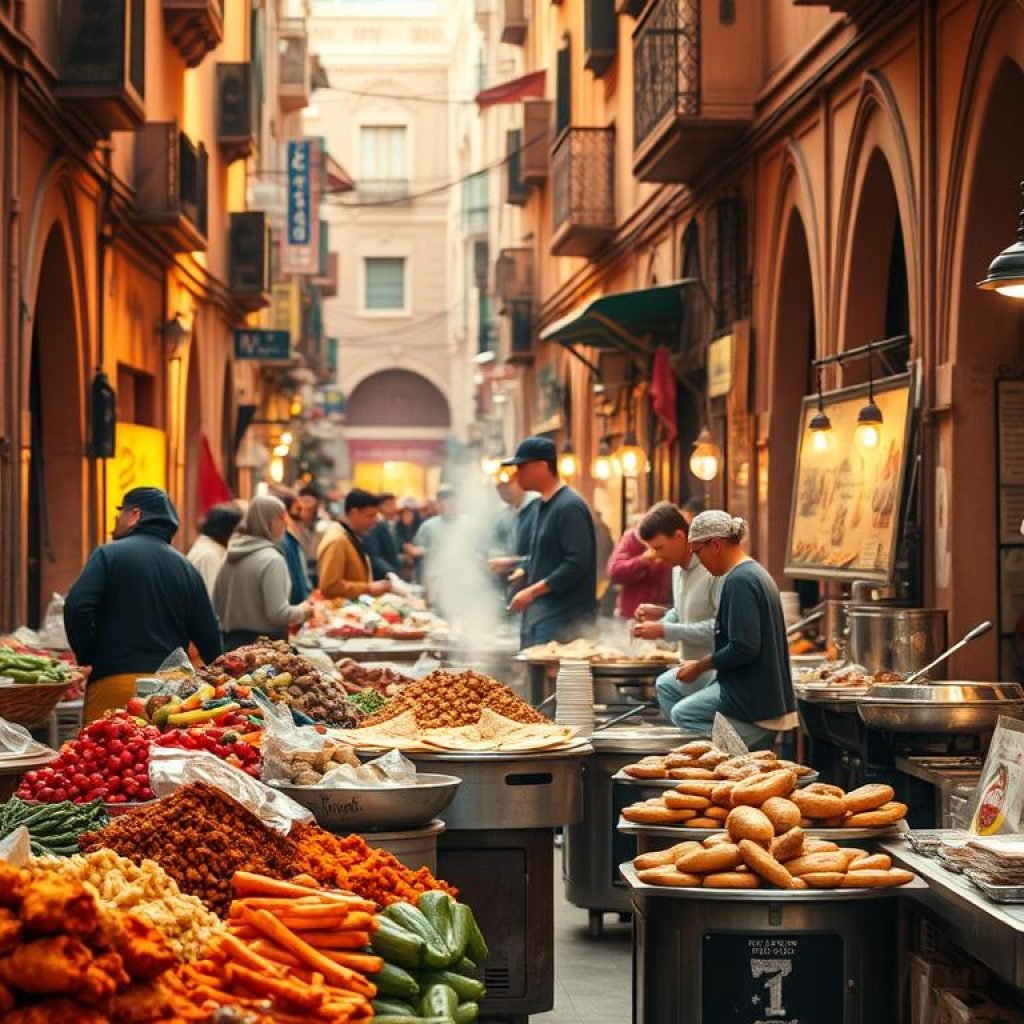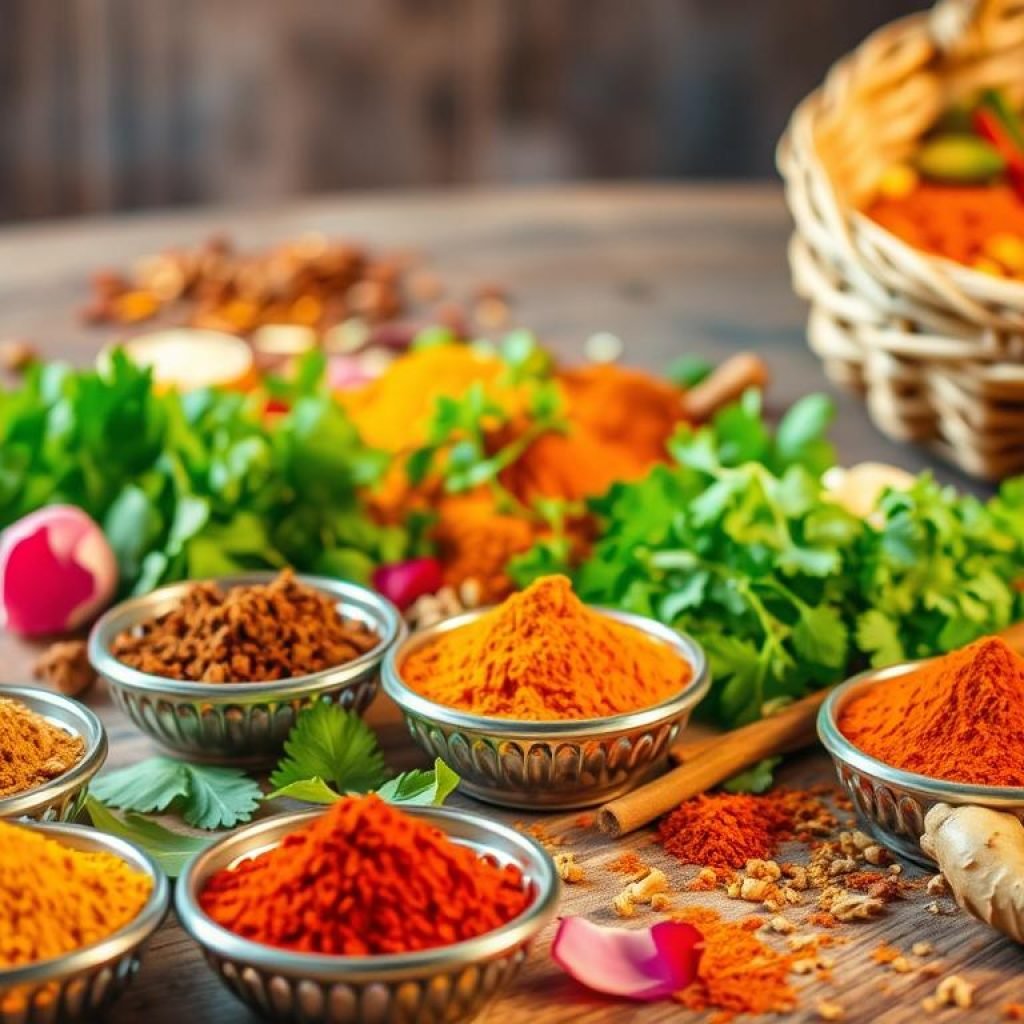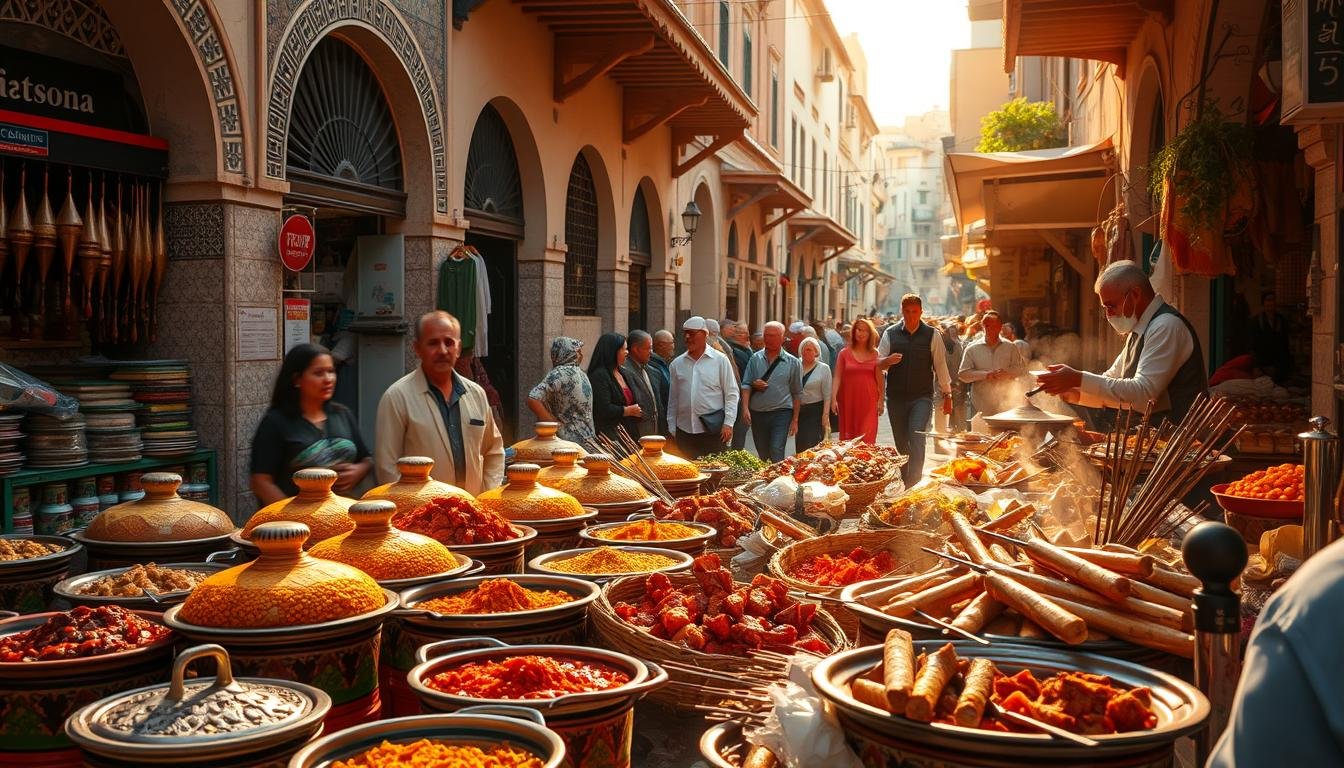What makes Moroccan street food so special? It’s the mix of traditional dishes, spices, and eating together that makes it unique. Moroccan cuisine is a big part of the country’s identity. You’ll find dishes like tagine and sfenj in the markets and food stalls.
Exploring Morocco’s streets, you’ll see street food is more than a snack. It’s a big part of the food culture. Dishes like harira soup and msemmen are enjoyed at certain times. Visit Moroccan street food markets to try traditional dishes like brochettes, bssara, and bastilla.
Key Takeaways
- Moroccan street food is key to the country’s food culture and economy, with over 1 million people depending on it.
- Traditional dishes like tagine, sfenj, and harira soup are big in Moroccan street food, showing the country’s rich food heritage.
- Moroccan street food is shaped by Berber, Arab, Andalusian, and Mediterranean cultures, showing the country’s diverse identity.
- Street food portions in Morocco are big, showing good value, with most dishes costing around 10 Moroccan Dirhams (about $1 USD).
- About 90% of street food vendors stick to traditional recipes, keeping the country’s food traditions alive.
- Moroccan street food is a feast for the senses, with vibrant markets, food stalls, and communal eating, making it a must-try for visitors.
The Rich History of Moroccan Street Food
Moroccan street food shows the country’s deep cultural roots. It mixes North African cuisine with authentic Moroccan recipes. This mix comes from Morocco’s strategic spot, where many cultures like the Romans, Arabs, and French have left their mark.
The history of Moroccan street food is rich and varied. Each dish, from spicy tagines to sweet pastries, tells a story.
Ancient Influences on Moroccan Cuisine
Today, you can still see the ancient touches in Moroccan food. Many dishes use ingredients and spices brought by traders and travelers. Ingredients like olives, olive oil, and preserved lemons are key in North African cuisine.
The Role of Trade in Shaping Flavors
Trade has greatly shaped Moroccan street food’s flavors. Morocco’s spot at the crossroads of Europe, Africa, and the Middle East made it a key trade hub. Merchants and travelers brought new ingredients and spices, making Moroccan cuisine unique and flavorful.
Popular Moroccan Street Foods to Try
Exploring Marrakech’s streets reveals a world of tasty Moroccan street food. The flavors and smells here reflect Morocco’s rich food culture. You’ll find everything from savory tagines to sweet pastries.
For a true taste of Moroccan street food, head to local markets. There, you can try popular dishes. For more on Moroccan cuisine and culture, check out this link. Don’t miss out on:
- Tagine: a hearty stew with meat, veggies, and dried fruits, cooked in a ceramic pot.
- Sfenj: sweet, deep-fried doughnuts, often sprinkled with sugar or honey.
- Mechoui: slow-roasted lamb, served with couscous or bread.
Moroccan street food is a mix of Arab, Berber, and Mediterranean tastes. Whether you crave something savory or sweet, Marrakech has it all.

Street Food Markets to Explore in Morocco
Exploring Morocco’s street food markets is a must. Marrakech’s bustling streets and Essaouira’s coastal charm offer a rich street food scene. Jemaa el-Fnaa in Marrakech is famous for its variety, including snails, sheep’s head, and tagines.
Fez’s medina is known for bissara and pigeon pastilla. Essaouira is great for fresh seafood, like sardine meatballs and grilled fish. Some popular dishes include:
- Sfenj, a traditional Moroccan doughnut
- Maakouda, Moroccan potato cakes
- Chebakia, a traditional sesame cookie
These markets are a unique and delicious experience. They let visitors try authentic Moroccan recipes in a lively atmosphere. Whether you’re after local specialties or just want to soak in the Moroccan market vibe, visiting is a must.
The Unique Spices in Moroccan Street Cuisine
Moroccan cuisine is famous for its blend of spices. These spices create unique flavors and aromas. In Moroccan street food, you’ll find dishes with cumin, turmeric, cinnamon, and saffron. These are key spices in North African cuisine and the best Moroccan street food.
Spices like cumin, turmeric, cinnamon, and saffron are staples in Moroccan cooking. They’re mixed with coriander, parsley, and paprika for complex flavors. This spice mix is what makes Moroccan street food so beloved.

Common Spices Used in Moroccan Cuisine
- Cumin
- Turmeric
- Cinnamon
- Saffron
- Coriander
- Paprika
These spices are in many dishes, from tagines to salads. Moroccan cuisine isn’t just savory, though. Sweet pastries and desserts also use spices like cinnamon, ginger, and nutmeg.
How to Enjoy Moroccan Street Food Safely
Exploring Morocco’s streets means trying the local street food. To enjoy delicious Moroccan street food safely, pick the right stalls. Look for places locals frequent, as they know the best spots.
Understanding local culture is key to enjoying Moroccan street food. Meals are shared, and guests get the best food as a sign of welcome. Being aware of these customs makes your experience richer.
- Choose stalls with a high number of Moroccan families dining
- Avoid stalls with predominantly tourists
- Verify the cleanliness of the stall and food handling practices
Follow these tips and know the local culture. You’ll enjoy authentic Moroccan recipes and have a great time exploring Moroccan street food.
Vegetarian and Vegan Options in Moroccan Street Food
Moroccan cuisine is famous for its rich flavors and aromas. While it’s mostly meat-based, there are many tasty vegetarian and vegan choices. Vegetables are key in traditional dishes, making it easy to find plant-based options. Sharing meals and enjoying company is a big part of Moroccan food culture, and veggie and vegan dishes are included.
In Moroccan street food, you’ll find many vegetarian and vegan dishes. Options include vegetable tagine, couscous, and harira. These are made with fresh veggies, spices, and herbs, great for those who don’t eat meat.
Delicious Vegetable Tagine Variations
Tagine is a traditional Moroccan stew with veggies, dried fruits, and spices. There are many veggie and vegan tagine options. You can try ones with chickpeas, carrots, and potatoes, or lentils and veggies.
Vegan Harira: A Comforting Soup
Harira is a warm and flavorful soup with veggies, lentils, and spices. Traditional harira has lamb stock, but vegan versions are just as tasty. Look for vegan harira with vegetable stock and spices for a cozy meal.
Moroccan cuisine offers a wide range of vegetarian and vegan dishes. From vegetable tagine to vegan harira, there’s something for everyone. So, why not try it and enjoy the rich flavors and aromas of Moroccan food culture?
The Art of Eating Moroccan Street Food
Trying Moroccan street food is a must for experiencing authentic Moroccan flavors. It’s not just about the food; it’s about the cultural experience too. Eating street food is a communal act, where meals are shared with others. This shows hospitality and respect in Moroccan culture.
In Morocco, the best street food is found in busy markets and souks. The air is filled with the smells and sounds of sizzling food. From savory tagines to sweet pastries, there’s something for everyone. Try eating with your hands like the locals do for a fun and authentic experience.
Some must-try dishes include bocadillos, sfenj, and mechoui. These dishes are not only tasty but also made with fresh, local ingredients. They’re often served with bread or couscous. Don’t miss out on local specialties like snail soup or grilled sardines for a unique taste.
To enjoy Moroccan street food fully, follow some basic etiquette. Always use your right hand when eating, as the left hand is considered unclean. Also, try a little bit of everything to show respect for the cook and the food.
By following these tips and being open to new experiences, you’ll dive into the world of Moroccan street food. Morocco is a food lover’s paradise with its rich flavors, vibrant markets, and warm hospitality. So, why not come and experience it for yourself and discover the authentic flavors of Moroccan street food?
Pairing Drinks with Moroccan Street Foods
Enjoying Moroccan street food is even better with the right drink. Moroccan cuisine’s rich flavors and aromas pair well with many beverages. Try traditional drinks like mint tea or fresh juices for an authentic taste.
Staying hydrated is key when trying Moroccan street food. The variety of flavors and spices calls for a refreshing drink. Fresh juices, made from fruits like oranges and apricots, are a favorite among locals and visitors.
Mint tea is a classic choice for a traditional experience. It’s a big part of Moroccan hospitality, welcoming guests with its refreshing flavor. Mint tea is great with Moroccan meals, enhancing the taste and health benefits.
Here are some drinks to try with Moroccan street food:
- Mint tea: a traditional and refreshing choice
- Fresh juices: made from seasonal fruits and perfect for hot days
- Orange juice: a classic and flavorful option
- Avocado smoothies: a healthy and delicious choice
Pairing your Moroccan street food with the right drink can make it even better. It enhances the flavors and aromas, creating a memorable experience. So, why not try something new and explore Moroccan drinks? Your taste buds will love it!
Making Moroccan Street Food at Home
To bring Moroccan flavors into your kitchen, you need to know the basics of Moroccan street food. Moroccan cuisine is a mix of Berber, Arab, and Mediterranean flavors. It offers a rich and varied culinary experience. Try making dishes like tagine, sfenj, or ma’akouda at home for an authentic taste.
Start by getting the right ingredients. Ras el Hanout, a Moroccan spice mix, is key. It can have up to 50 spices. You can also try instant pot recipes for dishes like chickpea soup or chicken stew. For a sweet treat, make Beghrir, Moroccan pancakes that are vegan and sugar-free.
- Vegetarian tagine variations, featuring a range of colorful vegetables and aromatic spices
- Vegan harissa lentil stew, a hearty and comforting dish perfect for any time of day
- Maakouda, crispy potato cakes that can be customized to be gluten-free, vegetarian, or vegan
Exploring Moroccan street food can introduce you to new flavors and ingredients. Moroccan cuisine is known for its unique spices, rich history, and cultural importance. Whether you want something spicy, sweet, or savory, making Moroccan street food at home is a great way to enjoy authentic Moroccan recipes.
The Future of Moroccan Street Food
Moroccan street food is winning hearts and taste buds worldwide. The future looks bright for this lively food scene. Emerging culinary trends hint at Moroccan flavors mixing with other cuisines, leading to new and exciting dishes.
The Moroccan food culture is a treasure trove of history and supports local businesses. Street vendors and small producers find work here. As delicious Moroccan street food gains fame, it could help bridge cultural gaps and deepen our love for Moroccan food.




Comment (0)